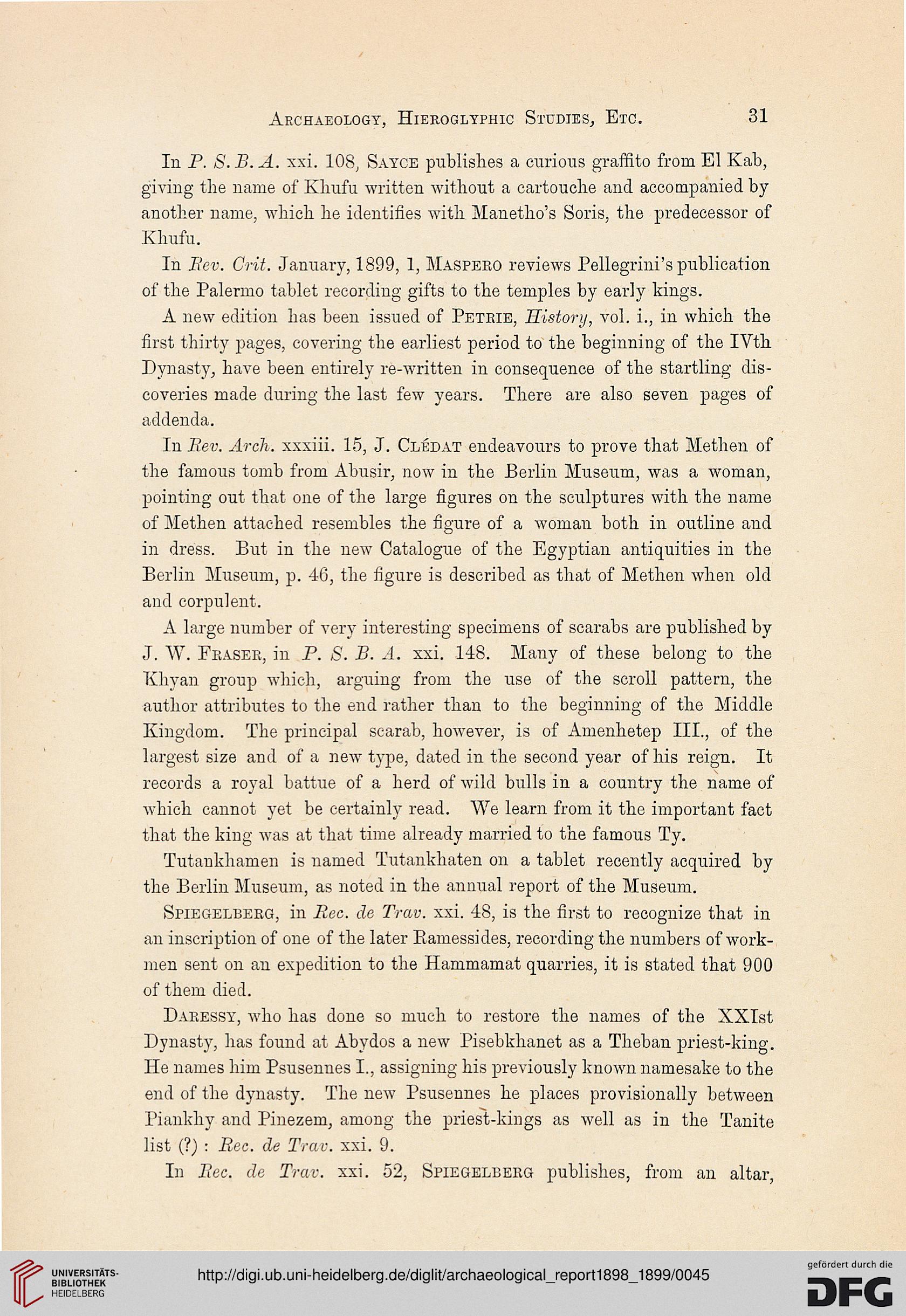Archaeology, Hieroglyphic Studies, Etc.
31
In P. S. B. A. xxi. 108, Sayce publishes a curious graffito from El Kab,
giving the name of Khufu written without a cartouche and accompanied by
another name, which he identifies with Manetho's Soris, the predecessor of
Khufu.
In Rev. Grit. January, 1899, 1, Maspero reviews Pellegrini's publication
of the Palermo tablet recording gifts to the temples by early kings.
A new edition has been issued of Petrie, History, vol. i., in which the
first thirty pages, covering the earliest period to the beginning of the IVth
Dynasty, have been entirely re-written in consequence of the startling dis-
coveries made during the last few years. There are also seven pages of
addenda.
In Rev. Arch, xxxiii. 15, J. Cledat endeavours to prove that Methen of
the famous tomb from Abusir, now in the Berlin Museum, was a woman,
pointing out that one of the large figures on the sculptures with the name
of Methen attached resembles the figure of a woman both in outline and
in dress. But in the new Catalogue of the Egyptian antiquities in the
Berlin Museum, p. 46, the figure is described as that of Methen when old
and corpulent.
A large number of very interesting specimens of scarabs are published by
J. W. Fraser, in P. 8. B. A. xxi. 148. Many of these belong to the
Khyan group which, arguing from the use of the scroll pattern, the
author attributes to the end rather than to the beginning of the Middle
Kingdom. The principal scarab, however, is of Amenhetep III., of the
largest size and of a new type, dated in the second year of his reign. It
records a royal battue of a herd of wild bulls in a country the name of
which cannot yet be certainly read. We learn from it the important fact
that the king was at that time already married to the famous Ty.
Tutankhamen is named Tutankhaten on a tablet recently acquired by
the Berlin Museum, as noted in the annual report of the Museum.
Spiegelberg, in Bee. de Trav. xxi. 48, is the first to recognize that in
an inscription of one of the later Bamessides, recording the numbers of work-
men sent on an expedition to the Hammamat quarries, it is stated that 900
of them died.
Daressy, who has done so much to restore the names of the XXIst
Dynasty, has found at Abydos a new Pisebkhanet as a Theban priest-king.
He names him Psusennes I., assigning his previously known namesake to the
end of the dynasty. The new Psusennes he places provisionally between
Piankhy and Pinezem, among the priest-kings as well as in the Tanite
list (?) : Bee. de Trav. xxi. 9.
In Bee. de Trav. xxi. 52, Spiegelberg publishes, from an altar,
31
In P. S. B. A. xxi. 108, Sayce publishes a curious graffito from El Kab,
giving the name of Khufu written without a cartouche and accompanied by
another name, which he identifies with Manetho's Soris, the predecessor of
Khufu.
In Rev. Grit. January, 1899, 1, Maspero reviews Pellegrini's publication
of the Palermo tablet recording gifts to the temples by early kings.
A new edition has been issued of Petrie, History, vol. i., in which the
first thirty pages, covering the earliest period to the beginning of the IVth
Dynasty, have been entirely re-written in consequence of the startling dis-
coveries made during the last few years. There are also seven pages of
addenda.
In Rev. Arch, xxxiii. 15, J. Cledat endeavours to prove that Methen of
the famous tomb from Abusir, now in the Berlin Museum, was a woman,
pointing out that one of the large figures on the sculptures with the name
of Methen attached resembles the figure of a woman both in outline and
in dress. But in the new Catalogue of the Egyptian antiquities in the
Berlin Museum, p. 46, the figure is described as that of Methen when old
and corpulent.
A large number of very interesting specimens of scarabs are published by
J. W. Fraser, in P. 8. B. A. xxi. 148. Many of these belong to the
Khyan group which, arguing from the use of the scroll pattern, the
author attributes to the end rather than to the beginning of the Middle
Kingdom. The principal scarab, however, is of Amenhetep III., of the
largest size and of a new type, dated in the second year of his reign. It
records a royal battue of a herd of wild bulls in a country the name of
which cannot yet be certainly read. We learn from it the important fact
that the king was at that time already married to the famous Ty.
Tutankhamen is named Tutankhaten on a tablet recently acquired by
the Berlin Museum, as noted in the annual report of the Museum.
Spiegelberg, in Bee. de Trav. xxi. 48, is the first to recognize that in
an inscription of one of the later Bamessides, recording the numbers of work-
men sent on an expedition to the Hammamat quarries, it is stated that 900
of them died.
Daressy, who has done so much to restore the names of the XXIst
Dynasty, has found at Abydos a new Pisebkhanet as a Theban priest-king.
He names him Psusennes I., assigning his previously known namesake to the
end of the dynasty. The new Psusennes he places provisionally between
Piankhy and Pinezem, among the priest-kings as well as in the Tanite
list (?) : Bee. de Trav. xxi. 9.
In Bee. de Trav. xxi. 52, Spiegelberg publishes, from an altar,





